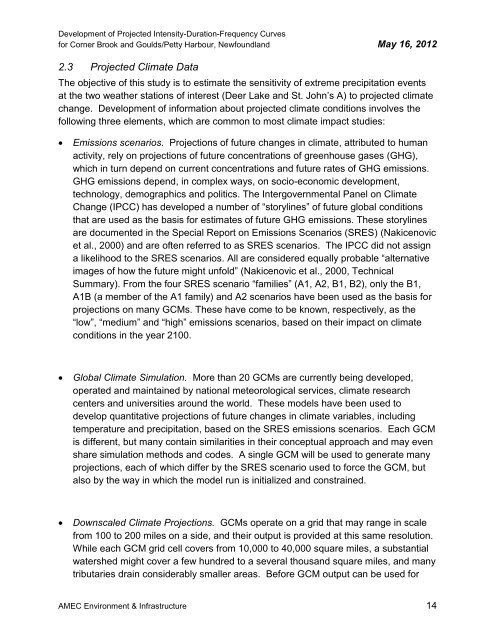Flood Risk and Vulnerability Analysis Project - Atlantic Climate ...
Flood Risk and Vulnerability Analysis Project - Atlantic Climate ...
Flood Risk and Vulnerability Analysis Project - Atlantic Climate ...
You also want an ePaper? Increase the reach of your titles
YUMPU automatically turns print PDFs into web optimized ePapers that Google loves.
Development of <strong>Project</strong>ed Intensity-Duration-Frequency Curves<br />
for Corner Brook <strong>and</strong> Goulds/Petty Harbour, Newfoundl<strong>and</strong> May 16, 2012<br />
2.3 <strong>Project</strong>ed <strong>Climate</strong> Data<br />
The objective of this study is to estimate the sensitivity of extreme precipitation events<br />
at the two weather stations of interest (Deer Lake <strong>and</strong> St. John’s A) to projected climate<br />
change. Development of information about projected climate conditions involves the<br />
following three elements, which are common to most climate impact studies:<br />
<br />
Emissions scenarios. <strong>Project</strong>ions of future changes in climate, attributed to human<br />
activity, rely on projections of future concentrations of greenhouse gases (GHG),<br />
which in turn depend on current concentrations <strong>and</strong> future rates of GHG emissions.<br />
GHG emissions depend, in complex ways, on socio-economic development,<br />
technology, demographics <strong>and</strong> politics. The Intergovernmental Panel on <strong>Climate</strong><br />
Change (IPCC) has developed a number of ―storylines‖ of future global conditions<br />
that are used as the basis for estimates of future GHG emissions. These storylines<br />
are documented in the Special Report on Emissions Scenarios (SRES) (Nakicenovic<br />
et al., 2000) <strong>and</strong> are often referred to as SRES scenarios. The IPCC did not assign<br />
a likelihood to the SRES scenarios. All are considered equally probable ―alternative<br />
images of how the future might unfold‖ (Nakicenovic et al., 2000, Technical<br />
Summary). From the four SRES scenario ―families‖ (A1, A2, B1, B2), only the B1,<br />
A1B (a member of the A1 family) <strong>and</strong> A2 scenarios have been used as the basis for<br />
projections on many GCMs. These have come to be known, respectively, as the<br />
―low‖, ―medium‖ <strong>and</strong> ―high‖ emissions scenarios, based on their impact on climate<br />
conditions in the year 2100.<br />
<br />
Global <strong>Climate</strong> Simulation. More than 20 GCMs are currently being developed,<br />
operated <strong>and</strong> maintained by national meteorological services, climate research<br />
centers <strong>and</strong> universities around the world. These models have been used to<br />
develop quantitative projections of future changes in climate variables, including<br />
temperature <strong>and</strong> precipitation, based on the SRES emissions scenarios. Each GCM<br />
is different, but many contain similarities in their conceptual approach <strong>and</strong> may even<br />
share simulation methods <strong>and</strong> codes. A single GCM will be used to generate many<br />
projections, each of which differ by the SRES scenario used to force the GCM, but<br />
also by the way in which the model run is initialized <strong>and</strong> constrained.<br />
<br />
Downscaled <strong>Climate</strong> <strong>Project</strong>ions. GCMs operate on a grid that may range in scale<br />
from 100 to 200 miles on a side, <strong>and</strong> their output is provided at this same resolution.<br />
While each GCM grid cell covers from 10,000 to 40,000 square miles, a substantial<br />
watershed might cover a few hundred to a several thous<strong>and</strong> square miles, <strong>and</strong> many<br />
tributaries drain considerably smaller areas. Before GCM output can be used for<br />
AMEC Environment & Infrastructure 14














